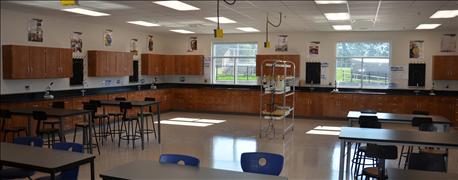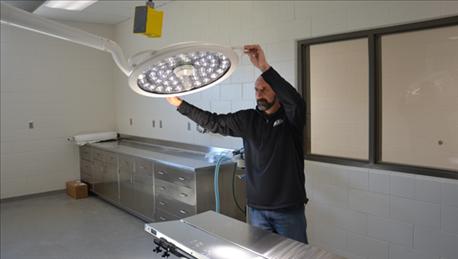
Fairfield High School sitting along Highway 33 in southern Elkhart County may look like a sleepy, rural consolidated school from the road. But if you stop and visit Kraig Bowers, the ag instructor and FFA advisor, you will find new state-of-the-art facilities for teaching agriculture classes. Plus, you’ll see a facility seldom found at high schools. It’s a large-animal room plus an attached surgical bay, equipped and waiting for students, animals and a new instructor for a veterinary careers program beginning in the fall of 2017.

NEW LAB SPACE: Here’s what can happen when school officials and the community commit to agriculture education as a priority. This new ag ed room at Fairfield High School features plenty of lab space.
“The school board decided to add some other facilities, and Superintendent Steve Thalheimer told me the ag facilities should be expanded at the same time,” Bowers says. “We had a classroom and shop, but virtually no lab facilities for teaching techniques common to animal science courses.
“He asked me what my dream ag teaching facility would look like, and I gave it a lot of thought. We decided that designating an area for animals and for veterinary career training for vocational-minded students would give high school students another opportunity to prepare for a career."
New ag space
Bowers and his students are already enjoying the new ag education teaching space. A spacious lab area has all the equipment needed to perform a wide range of experiments related to animal science, he says. Part of the area currently serves as a classroom, as well. He even has grow carts in the room to give students experience with plants. The recent addition is focused on animal science and doesn't include a greenhouse. Fitting a greenhouse on the school site would be difficult, Bowers says.

READY FOR ACTION: Kraig Bowers demonstrates the surgical lights over the small-animal operating table, which is part of the new vocational ag complex at Fairfield High School.
Even though the vet careers part of the program won’t start until next year, Bowers has already used the surgical bay and animal room for demonstrations with live animals, he says. The room is large enough that it will allow students in the future to learn artificial insemination techniques using live animals.
Part of the plan for the ag program includes fencing off a small pasture and raising sheep — most likely hair breeds — so there will always be animals for use in surgical demonstrations, Bowers says.
He intends to conduct a parasite study with the sheep. He’s picking hair sheep breeds because they tend to have more resistance to parasites.
Vet science program
Fairfield will hire either a registered veterinary technician or a DVM to teach the vocational vet careers course, Bowers says. That’s one reason it won’t become part of the curriculum until 2017.
The two-year program will include one year of classroom training and a second year where students intern with a veterinarian four days a week and come to school one day a week. Bowers envisions up to 40 participants in the program, and is already fielding calls from interested students. The vet science vocational program will be open to students from other schools, too.
Students will be able to earn a certified veterinary assistant degree. Bowers is excited to see this new phase of the program unfold.
About the Author(s)
You May Also Like




